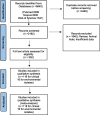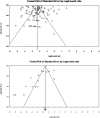Prevalence of Mycobacterium kansasii in clinical and environmental isolates, a systematic review and meta-analysis
- PMID: 38440139
- PMCID: PMC10911025
- DOI: 10.3389/fmicb.2024.1321273
Prevalence of Mycobacterium kansasii in clinical and environmental isolates, a systematic review and meta-analysis
Abstract
Background: Mycobacterium kansasii infection is one of the most common causes of non-tuberculosis mycobacterial (NTM) disease worldwide. However, accurate information on the global prevalence of this bacterium is lacking. Therefore, this study was conducted to investigate the prevalence of M. kansasii in clinical and environmental isolates.
Methods: Databases, including PubMed, Scopus, and the Web of Science, were utilized to gather articles on the prevalence of M. kansasii in clinical and environmental isolates. The collected data were analyzed using Comprehensive Meta-Analysis software.
Results: A total of 118 and 16 studies met the inclusion criteria and were used to analyze the prevalence of M. kansasii in clinical and environmental isolates, respectively. The prevalence of M. kansasii in NTM and environmental isolates were 9.4 and 5.8%, respectively. Subsequent analysis showed an increasing prevalence of M. kansasii over the years. Additionally, the results indicated a significant difference in the prevalence of this bacteria among different regions.
Conclusion: The relatively high prevalence of M. kansasii among NTM isolates suggests the need for further implementation of infection control strategies. It is also important to establish appropriate diagnostic criteria and management guidelines for screening this microorganism in environmental samples in order to prevent its spread, given its high prevalence in environmental isolates.
Keywords: CMA; Mycobacterium kansasii; NTM; meta-analysis; prevalence.
Copyright © 2024 Narimisa, Bostanghadiri, Goodarzi, Razavi and Jazi.
Conflict of interest statement
The authors declare that the research was conducted in the absence of any commercial or financial relationships that could be construed as a potential conflict of interest.
Figures












Similar articles
-
Prevalence of antibiotic resistance in clinical isolates of Mycobacterium kansasii: a systematic review and meta-analysis.Expert Rev Anti Infect Ther. 2024 Aug;22(8):669-679. doi: 10.1080/14787210.2024.2313051. Epub 2024 Feb 6. Expert Rev Anti Infect Ther. 2024. PMID: 38294514
-
Molecular Identification, and Characterization of Mycobacterium kansasii Strains Isolated from Four Tuberculosis Regional Reference Laboratories in Iran During 2016-2018.Infect Drug Resist. 2020 Jul 7;13:2171-2180. doi: 10.2147/IDR.S245295. eCollection 2020. Infect Drug Resist. 2020. PMID: 32753913 Free PMC article.
-
Mycobacterium kansasii and M. scrofulaceum isolates from HIV-negative South African gold miners: incidence, clinical significance and radiology.Int J Tuberc Lung Dis. 1999 Jun;3(6):501-7. Int J Tuberc Lung Dis. 1999. PMID: 10383063
-
Interferon Gamma Release Assays in Patients with Respiratory Isolates of Non-Tuberculous Mycobacteria - a Preliminary Study.Pol J Microbiol. 2019;68(1):15-19. doi: 10.21307/pjm-2019-002. Pol J Microbiol. 2019. PMID: 31050249 Free PMC article.
-
Efficacy and treatment outcome of infected patients with pulmonary Mycobacterium kansasii: A systematic review.J Clin Tuberc Other Mycobact Dis. 2024 Jul 6;36:100463. doi: 10.1016/j.jctube.2024.100463. eCollection 2024 Aug. J Clin Tuberc Other Mycobact Dis. 2024. PMID: 39139717 Free PMC article. Review.
Cited by
-
Evaluation of a Commercial Multiplex Real-Time PCR with Melting Curve Analysis for the Detection of Mycobacterium tuberculosis Complex and Five Nontuberculous Mycobacterial Species.Microorganisms. 2024 Dec 26;13(1):26. doi: 10.3390/microorganisms13010026. Microorganisms. 2024. PMID: 39858795 Free PMC article.
References
-
- Agizew T., Basotli J., Alexander H., Boyd R., Letsibogo G., Auld A., et al. . (2017). Higher-than-expected prevalence of non-tuberculous mycobacteria in HIV setting in Botswana: implications for diagnostic algorithms using Xpert MTB/RIF assay. PLoS One 12:e0189981. doi: 10.1371/journal.pone.0189981, PMID: - DOI - PMC - PubMed
Publication types
LinkOut - more resources
Full Text Sources
Miscellaneous

